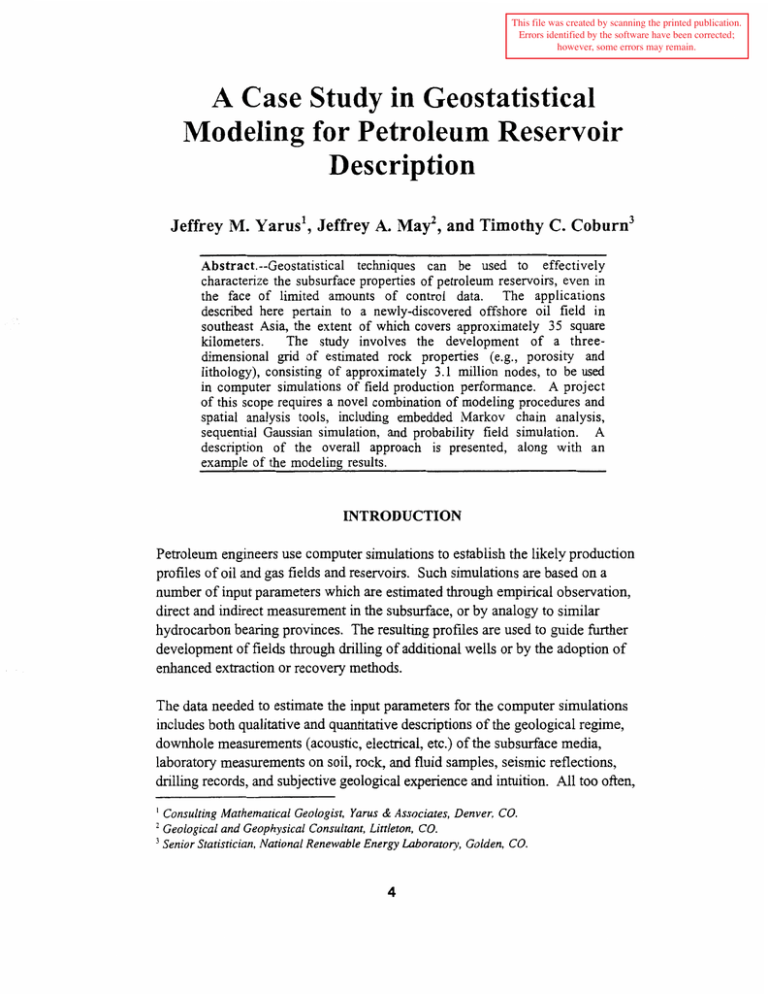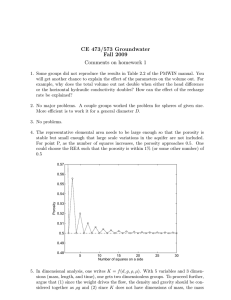Document 11863905
advertisement

This file was created by scanning the printed publication. Errors identified by the software have been corrected; however, some errors may remain. A Case Study in Geostatistical Modeling for Petroleum Reservoir Description Jeffrey M. ~ a r u s ' ,Jeffrey A. ~ aand ~Timothy ~ C., coburn3 Abstract.--Geostatistical techniques can be used to effectively characterize the subsurface properties of petroleum reservoirs, even in the face of limited amounts of control data. The applications described here pertain to a newly-discovered offshore oil field in southeast Asia, the extent of which covers approximately 35 square kilometers. The study involves the development of a threedimensional gnd of estimated rock properties (e.g., porosity and lithology), consisting of approximately 3.1 million nodes, to be used in computer simulations of field production performance. A project of this scope requires a novel combination of modeling procedures and spatial analysis tools, including embedded Markov chain analysis, sequential Gaussian simulation, and probability field simulation. A description of the overall approach is presented, along with an example of the modeling results. INTRODUCTION Petroleum engineers use computer simulations to establish the likely production profiles of oil and gas fields and reservoirs. Such simulations are based on a number of input parameters which are estimated through empirical observation, direct and indirect measurement in the subsurface, or by analogy to similar hydrocarbon bearing provinces. The resulting profiles are used to guide further development of fields through dnlling of additional wells or by the adoption of enhanced extraction or recovery methods. The data needed to estimate the input parameters for the computer simulations includes both qualitative and quantitative descriptions of the geological regime, downhole measurements (acoustic, electrical, etc.) of the subsurface media, laboratory measurements on soil, rock, and fluid samples, seismic reflections, dnlling records, and subjective geologcal experience and intuition. All too often, - - ' Consulting Mathematical Geologist, Yarus & Associates, Denver, CO. ' Geological and Geophysical Consultant, Littleton, CO. Senior Statistician, National Renewable Energy Laboratory, Golden, CO. however, many of the requisite data are missing or simply unavailable, a situation which is particularly true in the case of newly-discovered fields, or in foreign andlor offshore settings, where data collection can be a comparatively expensive and logistically difficult proposition. Historically, the two most common ways to remedy missing data have been to impute it from knowledge of other producing fields in geologically similar environments (best case) or to simply "make it up" (worst case). As an alternative, the discipline and tools of geostatistics have recently been shown to provide a more rigorous and statistically-reliable means of estimating the simulation parameters by talung advantage of the notion of spatial correlation that is so central to the investigation of all earth processes and phenomena. This paper discusses the effectiveness of the geostatistical approach in a laterally extensive geographic setting, and with the additional limitation of minimal control points and other tangible data. A number of spatial analysis tools, including embedded Markov chain analysis, conditional simulation, and probability field simulation are combined in novel ways to produce a three-dimensional gnd of parameter estimates encompassing approximately 3.1 million nodes. A description of the overall modeling approach is presented, along with an example of the modeling results. STUDY SETTING The present study involves a newly-discovered offshore oil field in southeast Asia for which a plan of development is necessary to satisfy the contractual requirements of the business concession. Three successful wells (A, B, and C) have been drilled. Drilling records, along with preliminary seismic data and initial production tests on the wells, confirm the presence of hydrocarbons in an area covering approximately 35 square kilometers. Because of the geographical extent of the field, and the high cost of dnlling additional wells, it is desirable to develop the most precise model of the reservoir possible, prior to selecting additional drilling sites or production platform locations. Such a model must reliably characterize the degree and lateral extent of all reservoir properties which affect fluid flow and hydrocarbon production. Conceptual Geological Framework Preliminary regional studies of the field area identified the presence of an ancient rift system filled with clastic sediment, sourcing from the northeast. The hydrocarbon-bearing interval (the reservoir) of the field is located in one particular subsurface horizon, which was apparently deposited early in the rift fill sequence. Using this information, a conceptual model was developed which establishes the depositional environment as being a fluvial dominated, fan delta system. Available Data The data set consists of ten seismic lines from an early 2-D survey over the region, and information from three wells dnlled along a general northwest-tosoutheast transect in the central southeast quadrant of the study area, the wells being spaced at intervals of approximately 2000 meters. During the drilling operation, cores were cut from two of the wells and sent to the laboratory to support rock studies. Conventional suites of wireline logs (including sonic, density, resistivity, neutron, and gamma ray) were run in all three wells. 3(C Well Location 4 Shot Point/ Pseudo wells I Values of reservoir parameters at the well locations were determined from laboratory measurements and examination of the core material, as well as from numerical analysis of the well logs. In pamcular, individual values of porosity were obtained for each half-foot segment of the reservoir. Similarly, each half-foot segment was classified into one of four primary lithologies, or rock types--chamel sands, delta front sands, overbank sands and muds, and lacustrine muds--identified by the project geologists. Of these four lithologies, the channel sands are presumed to have the greatest potential for production. The resulting collection of porosity measurements and lithology classifications comprises approximately 2,500 data pairs per well. Based on further studies of the cores, analysis of the wireline logging runs, and interpretation of the seismic lines, the following additional conclusions were formulated: (1) the field is bounded by at least two major faults, with Well B being situated outside these boundaries (Figure 1); (2) drainage is controlled, in part, by east-west trending faults; (3) four major depositional cycles (Intervals 1 to 4), separated by non-permeable shale barriers, can be identified which effectively subdivide the total reservoir into separate producing units of varying thickness; (4) the principle orientation of the channel sands, the dominant reservoir lithology, is also east to west; (5) the geometry of the channel sands is represented by an average length-to-width ratio of approximately 10:1 (taken in part from results reported by Fielding and Crane (1987) and Knutson and Boardman (1 978)); and (6) the median estimated thickness of the channel sands is 6 fi. EXPANDING AERIAL DATA COVERAGE THROUGH PSEUDO WELL DEVELOPMENT By themselves, the three wells do not constitute an adequate geographic sampling of the reservoir fiom which to develop a three-dimensional model. Therefore, in order to increase the aerial distribution of "sampling" locations and to facilitate geostatistical interpolation, fourteen pseudo wells were introduced. Using the process described below, these pseudo wells were created in such a way as to reflect the nature of the reservoir observed at the actual dnllsite locations, adjusted for the features of the conceptual geological framework, relationships extracted from geological outcrop studies, and trends observed in the seismic data. Pseudo well sites were determined to coincide with several of the shot point locations identified along the ten seismic lines, resulting in the "sampling" coverage illustrated in Figure 1. The shot point locations provided a convenient additional data source in that the seismic velocity recorded at these sites could be used to calculate acoustic impedance (AI), a continuous reservoir property fi-om which the boundaries of the four major depositional cycles could be estimated. To do so, log suites and synthetic seismograms fiom the three wells were manually depthshifted to obtain an optimum visual alignment of all petrophysical markers. This identification of the major cycle boundaries was corroborated through an automated "correlation" approach (Olea, 1988). The depths associated with these boundaries were then projected to the acoustic impedance trace at each pseudo well location. , a. Set of Markov sequcm c e s model for one interval U CONCEPTUAL GEOLOGICAL NODEL Pseudo-Well ~ocation:. c. Slacked Fan Delta sequen comprising a n interval Figure 2.--The process for determining lithology in pseudo wells Markov Modeling of Lithology The second stage of pseudo well construction involved overprinting a vertical sequence of lithologies at each location. Embedded Markov chain analysis (Davis, 1986) was used to develop these sequences based on the transition probabilities (bottom to top) observed in the actual wells. For illustration purposes, Table 1 shows the transition probabilities for Interval 1 computed over the three wells. Table 1.--Interval 1 transition probabilities (bottom to top) for the four lithologies To Channel Sands Delta Front Sands Overbank Sands & Muds Lacustrine Muds Channel Sands 0 0 .78 .22 Delta Front Sands .28 0 .67 0 .19 .82 0 0 Lithology From Overbank Sands & Muds Lacustrine Muds Applying the marginal vectors, seven different lithologic sequences were generated for each of the four intervals at each pseudo well location. Stacking the interval sequences together resulted in 28 possibilities per pseudo well, from which the most likely case was selected by subjective comparison to the respective acoustic impedance depth traces, gwing due consideration to the conceptual geological model. The result of this effort was the assignment of a lithology classification to each half-foot depth interval in each of the pseudo wells (Figure 2). Determination of Porosity Via Sequential Gaussian Simulation The third stage of pseudo well construction involved determination of a value of porosity for each half-foot depth interval. This task required two critical inputs: (1) the cumulative distribution (CDF) of porosity for each lithology within each of the four major intervals, combining information across wells; and (2) a vertical correlogram of porosity for each of the four intervals (combining information across wells and ignoring lithology). The CDFs were used to guarantee that the statistical distribution of porosity values in the pseudo wells matched that of porosity values in the original wells; and the correlogram, which measures the degree to which porosity changes from one depth to another, was used to insure that the vertical spatial distributions of porosity in the pseudo wells and the original wells were aligned. Given the CDFs and correlograms described above, porosity values for each individual depth in each pseudo well were determined using sequential Gaussian simulation (Deutsch and Joumel, 1992), a form of conditional simulation, in the following way. For each pseudo well, a vertical depth was selected at random from its vertical section. The interval and lithology associated with that depth were identified, and a porosity value was then randomly selected employing the appropriate CDF. This Monte-Carlo-like approach was successively repeated for every depth in the selected well. When a selected depth was located near one that had been previously simulated (i.e., within the range of correlation defined by the appropriate correlogram), and the two depths were associated with the same lithology, the value of porosity at the first depth influenced determination of the value at the second. The degree of influence exerted was dependent on the correlation coefficient defmed by the conelogram for the distance (in depth) separating the two. 3-D PROPAGATION OF LITHOLOGY AND POROSITY USING PROBABILITY FIELD SIMULATION Using information from the three wells and the fourteen, fully-populated pseudo wells, a full three-dimensional model of the reservoir was developed. The initial step was to construct a rectangular three-dimensional network grid consisting of approximately 3.1 million nodes. Grid dimensions were set at 180, x 87, x 200, cells, with individual cell dimensions being x = 150 ft, y = 150 ft, and z = 5 ft (the z-dimension represents the thickness of one reservoir layer). A grid of this density was deemed necessary to depict the detailed lithologic changes characteristic of this reservoir. Probability field simulation (Srivastava, 1992) was used to propagate porosity values and lithology classifications from the wells and pseudo wells to the individual grid node locations. Separate simulations were conducted for the two quantities, the results of which were subsequently combined for purposes of describing the reservoir in a multivariate sense. Like sequential Gaussian simulation, the use of probability field simulation (another forrn of the more general technique of conditional simulation) required information about the statistical distribution of the reservoir properties, as characterized by their CDFs, as well as spatial variation in both the vertical and lateral directions, as characterized by the appropriate correlograms. Because lithology is not continuous, CDFs and directional correlograms for this quantity were determined using an indicator variable (having values 1 or 0) which designates the presence or absence of the specific lithology in question. In the case of porosity, spatial variation was represented in the vertical sense using the same correlogram (described above) used to establish porosity values in the pseudo wells. To characterize the spatial variation in the lateral sense, additional directional correlograms for each major interval were constructed using the porosity values available in all three wells and fourteen pseudo wells. Similarly, both vertical and lateral correlograms were developed for each lithology within each major interval (combining information across all wells and pseudo wells) based on the assigned indicator values. The application of probability field simulation, the algorithm for which is described more fully by Srivastava (1992), required the development of a threedimensional grid of randomly-assigned probabilities (a probability template) based on both the vertical and lateral correlograms of the quantity of interest. This grid had the same physical dimensions as the simulation grid, with each node of the probability template corresponding to a node on that grid. The probability values assigned to the nodes were then used to select values of porosity or lith- ology from the appropriate CDFs, resulting in a fully-populated simulation grid. EXAMPLE OF THE SIMULATION RESULTS Based on the dimensions of the simulation gnd, the reservoir was arbitrarily subdivided into 200 five-foot layers to optimize precision and to better take advantage of the available computing resources. All results were generated on Unix-based workstations, using a combination of proprietary and commerciallyavailable code. Individual simulations of both porosity and lithology were developed for each of the 200 layers, with several realizations of each layer being produced. Figure 3 graphically illustrates the results for one layer of porosity, depicting a lateral gradational character across the reservoir which closely mimics input fiom the conceptual geological model, along with the well data and seismic interpretations. LAYER (lightest sliadirig = h i g l i e s t porosity) Figure 3.-Simulation results for porosity in one reservoir layer SUMMARY A number of geostatistical techniques and other quantitative methods, including conditional simulation, probability field simulation, and Markov analysis, were combined to Mly characterize and model a large-scale oil reservoir. Drawing on concomitant information fiom a number of sources, the unique process that was employed allowed the complicating situation of a limited number of control points (wells) to be overcome. The study resulted in reservoir models which exactly honored the control points, and which conoborated the field production profiles of other independent engineering tests. The geostatistical approach, however, yielded results having much more lateral and vertical detail which could be used to more effectively guide the placement of future additional wells and/or dnlling platforms. REFERENCES Davis, John C. 1986. Statistics and data analysis in geology, 2nd ed. New York: John Wiley & Sons. 646 p. Deutsch, C. V. and A. G. Journel. 1992. GSLIB--geostatistical software library and user's guide. New York: Oxford University Press. 2 diskettes and 340 p. Fielding, C. R. and R. C. Crane. 1987. An application of statistical modeling to the prediction of hydrocarbon recovery factors in fluvial reservoir sequences, in Recent Development in Fluvial Sedimentology (F. G. Ethndge, R. M. Flores, and M. D. Harvey, eds.). Society of Economic Paleontology and Mineralogy, Special Publication 39, p. 32 1-327. Knutson, C. F. and C. R. Boardman. 1978. Continuity and permeability development in the tight gas sands of the eastern Uinta Basin, Utah. Proceedings of the Fourth DOE Symposium on Enhanced Oil & Gas Recovery and Improved Drilling Methods, v. 2, p. E-2/1-24. Olea, hcardo A. 1988. CORRELATOR--An interactive computer system for lithostratigraphic correlation of wireline logs. Lawrence, KS: Kansas Geologcal Survey, Petrophysical Series 4. 84 p. Srivastava, R. M. 1992. Reservoir characterization with probability field simulation. Proceedings of the 67th Annual Technical Conference and Exhibition of Society of Petroleum Engineers, SPE Publication 24753, p. 927-938. BIOGRAPHICAL SKETCH - Jeffrey M. Yams is a consulting mathematical geologst and principal in the firm Yams & Associates in Denver, Colorado. He holds a Ph.D. in geology from the University of South Carolina, and specializes in applications of geostatistics in petroleum reservoir characterization, geoscientific computer mapping, and geostatistical software development. Jeffrey A. May is an independent consulting geologist based in Littleton, Colorado. He holds a Ph.D. in geology from Rice University, and specializes in sedimentology, seismic interpretation, and sequence stratigraphy. Timothy C. Cobum is senior statistician at the National Renewable Energy Laboratory in Golden, Colorado. He holds a Ph.D. is statistics fi-om Oklahoma State University, and specializes in the analysis and modeling of energy and environmental data, with particular emphasis on geoscience investigations.






